American actress Angie Dickinson (1931) starred on television as Sergeant Leann 'Pepper' Anderson in the successful 1970s crime series Police Woman. Her trade marks are her honey blonde hair, her large brown eyes, a voluptuous figure and her deep sultry voice. She has appeared in more than 50 films, including European productions such as the French thriller Un homme est mort/The Outside Man (Jacques Deray, 1972).
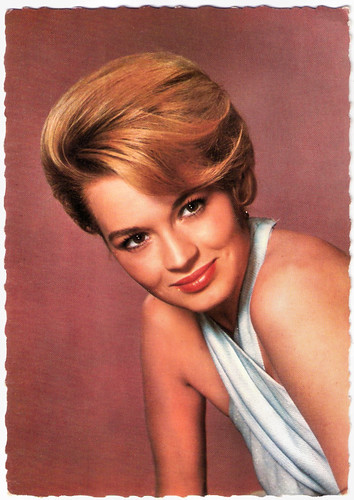
French postcard by E.D.U.G., no. 194.
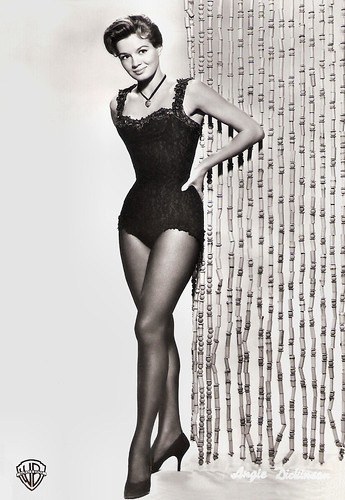
Italian postcard by Bromofoto, Milano, no. 1680. Photo: Warner Bros. Publicity still for Rio Bravo (Howard Hawks, 1959).
Angie Dickinson was born Angeline Brown (called Angie) in the North Dakota prairie town of Kulm in 1931. She was the second of three daughters of Fredericka (Hehr) and Leo Henry Brown, a newspaper editor and publisher of The Kulm Messenger and The Edgeley Mail. The family left North Dakota in 1942, when Angie was 11 years old, moving to Burbank, California. She attended Glendale College and Immaculate Heart College. At Glendale College, she met Gene Dickinson, a star on the school's football team. She became Angie Dickinson in 1952, when she married Gene. They divorced in 1959.
In 1953, she entered a local preliminary for the Miss America contest one day before the deadline and took second place. In August of the same year, she was one of five winners in a beauty contest sponsored by NBC and landed a spot as one of six long-stemmed showgirls on The Jimmy Durante Show. On The Jimmy Durante Show she met Frank Sinatra, who was a guest star on the TV show and they would have a 10-year affair.
Dickinson appeared in several television variety shows, including The Colgate Comedy Hour. In the cinema, she got her first bit part in the Doris Day comedy Lucky Me (Jack Donohue, 1954) and gained fame in the television series The Millionaire (1955).
Dickinson had her first leading role in the Western Gun the Man Down (Andrew V. McLaglen, 1956) with James Arness. It was followed by the Sam Fuller cult film China Gate (1957), which depicted an early view of the First Indochina War. Dickinson played a Eurasian good-time girl whose marriage to Gene Barry is derailed by the birth of her Chinese baby.
In 1959, she got her breakthrough role opposite John Wayne and Dean Martin in the Western Rio Bravo (Howard Hawks, 1959). She played a flirtatious gambler called 'Feathers' who becomes attracted to the town sheriff played by her childhood idol John Wayne. Her success then spiralled until she became one of Hollywood's top film stars.
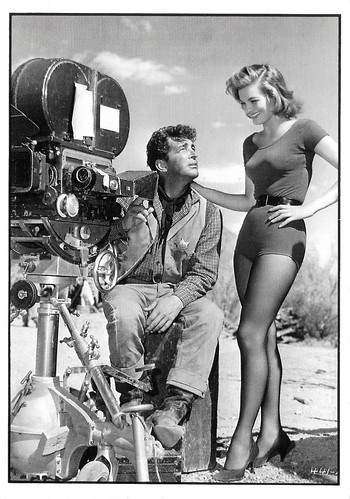
French postcard in the Entr'acte series by Éditions Asphodèle. Mâcon, no. 006/7. Collection: B. Courtel / D.R. Dean Martin and Angie Dickinson in 1958 at the set of Rio Bravo (Howard Hawks, 1959). Caption: Dean Martin and his partner Angie Dickinson behind the camera for a break.

Italian postcard by Bromofoto, Milano, no. 1748. Photo: Warner Bros. Angie Dickinson in Ocean's Eleven (Lewis Milestone, 1960).

Spanish postcard by Postal Oscarcolor, no. 419. Photo: Angie Dickinson, Errol John and Roger Moore in The Sins Of Rachel Cade (Gordon Douglas, 1961).
Angie Dickinson became one of Hollywood's more prominent leading ladies of the 1960s. She appeared in the heist film Ocean's 11 (Lewis Milestone, 1960) with friends Frank Sinatra and Dean Martin.
She played the title role in Jean Negulesco's Jessica (1962) with Maurice Chevalier, in which she played a young midwife resented by the married women of a Sicilian town.
In The Killers (Don Siegel, 1964), a film originally intended to be the very first made-for-television movie but released to theatres due to its violent content, Dickinson played a femme fatale opposite Lee Marvin, John Cassavetes and future U.S. President Ronald Reagan in his last film role. It was a remake of the 1946 version based on a story by Ernest Hemingway.
She appeared in a star-studded The Chase (Arthur Penn, 1966), along with Marlon Brando, Jane Fonda, Robert Redford, and Robert Duvall.
Dickinson's best film of this era was arguably the cult classic Point Blank (John Boorman, 1967), a lurid crime drama with Lee Marvin as a criminal betrayed by his wife and best friend and out for revenge. The film epitomised the stark urban mood of the period, and its reputation has grown through the years.
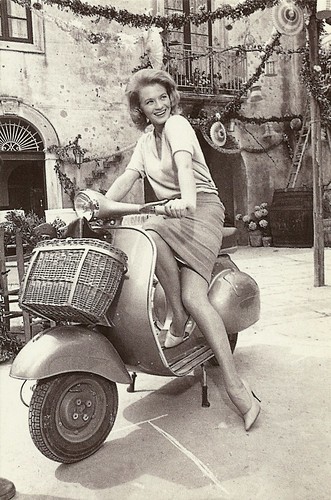
Italian postcard by Ed Graphicarta, Pontedera for Piaggio. Kit Postcards Vespa. Dickinson was in Italy for at least two films: Jessica (Jean Negulesco, Oreste Palella, 1962), shot in Sicily but also at the Roman DEAR studios, and Rome Adventure (Delmer Daves 1962), starring Suzanne Pleshette and Troy Donahue.
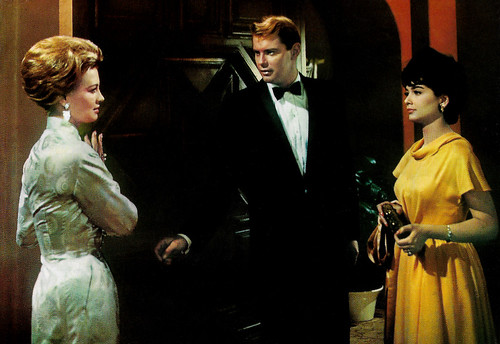
Spanish postcard by CyA, no. 35. Photo: Warner Bros. Angie Dickinson, Troy Donahue and Suzanne Pleshette in Rome Adventure (Delmer Daves, 1962).

Small Dutch collectors card.
In 1971, Angie Dickinson played a lascivious substitute high school teacher in the dark comedy Pretty Maids All in a Row (Roger Vadim, 1971), in which her character seduces a sexually inexperienced student against the backdrop of a series of murders of female students at the same high school. It was a box-office failure.
The following year, she played opposite Jean-Louis Trintignant in the French thriller Un homme est mort/The Outside Man (Jacques Deray, 1972), which was shot in LA.
One of Dickinson's best known and most sexually provocative roles was the tawdry widow Wilma McClatchie from the Great Depression romp Big Bad Mama (Steve Carver, 1974) with William Shatner and Tom Skerritt. Although well into her forties at the time, she appeared nude in several scenes, which created interest in the film and a new generation of male fans for Dickinson.
In 1974, she returned to TV to play in an episode in the hit anthology series Police Story. That one guest appearance proved to be so popular that NBC offered Dickinson her own television show which became a ground-breaking weekly police series called Police Woman, the first successful dramatic television series to feature a woman in the title role.
Sam Kashner in Vanity Fair: Her Sergeant Suzanne 'Pepper' Anderson was among the first of a new wave of tough, resourceful female action heroes who could hold their own in a man’s world. She was perfect for the role — that independent spirit coupled with a willingness to go undercover as a hooker or a moll, to be 'eye candy'" The show became a hit, reaching number one in many countries, and ran from 1974 to 1978. Dickinson won a Golden Globe award, and received Emmy nominations for three consecutive years.
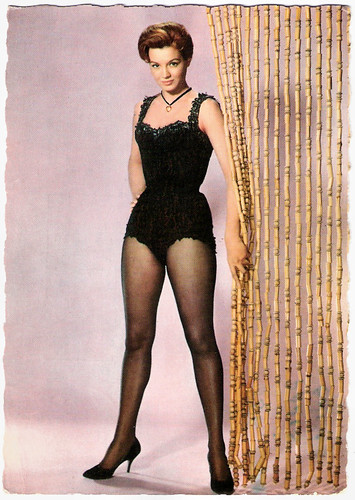
French postcard by E.D.U.G., no. 51.
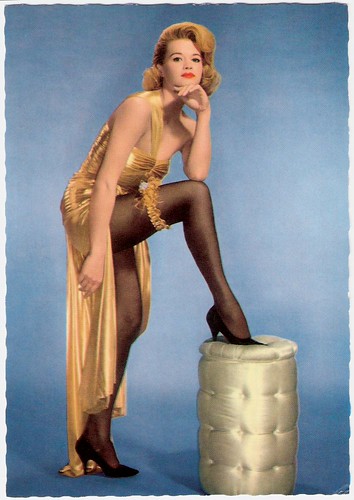
German postcard by ISV, Sort. 11/6.
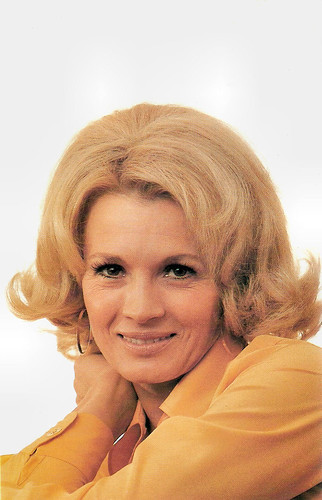
American postcard by Coral-Lee, Rancho Cordova, no. CL/Personality # 52. Photo: Douglas Kirkland, 1980.
Angie Dickinson returned to the cinema in the erotic thriller Dressed to Kill (Brian De Palma, 1980). The role of Kate Miller, a sleek, elegantly dressed, unsatisfied wife who embarks on a daytime tryst with a stranger, earned her a 1981 Saturn Award for Best Actress. Dressed to Kill was a sensation at the box office, in part because of the controversy over the film’s mingling of sex and violence.
She then starred in several TV movies, and had a pivotal role in the mini-series Hollywood Wives (Robert Day, 1985), based on a novel by Jackie Collins. Dickinson reprised her role as Wilma McClatchie for Big Bad Mama II (Jim Wynorski, 1987). In the TV miniseries Wild Palms (1993), produced by Oliver Stone, she was the sadistic, militant sister of Senator Tony Kruetzer (Robert Loggia). That same year, she starred as a ruthless Montana spa owner in Even Cowgirls Get the Blues (Gus Van Sant, 1993) with Uma Thurman. Sydney Pollack cast her as the prospective mother-in-law of Greg Kinnear in the romantic comedy Sabrina (1995) starring Harrison Ford, a remake of the Billy Wilder classic.
During the first decade of the Third Millennium, Dickinson acted out the alcoholic, homeless mother of Helen Hunt's character in Pay It Forward (Mimi Leder, 2000); the grandmother of Gwyneth Paltrow's character in the road trip film Duets (Bruce Paltrow, 2000), and made a brief cameo in the remake Ocean's 11 (Steven Soderbergh, 2001) with George Clooney and Brad Pitt.
After her divorce from Gene Dickinson in 1960, she married Burt Bacharach in 1965. They remained a married couple for 15 years. Their daughter, Lea Nikki, known as Nikki, arrived a year after they were married. Born three months prematurely, Nikki suffered from chronic health problems, including visual impairment; she was later diagnosed with Asperger syndrome. Burt composed the music of the song 'Nikki' for their fragile young daughter, and Angie rejected many roles to focus on caring for their daughter. In 2007, the 40-years-old Nikki killed herself by suffocation in her apartment in the Ventura County suburb of Thousand Oaks.
Angie Dickenson's most recent feature film is Elvis Has Left the Building (Joel Zwick, 2004), starring Kim Basinger as a cosmetics saleswoman who accidentally kills a series of Elvis impersonators as they travel to a convention in Las Vegas. Dickinson plays Basinger's mother, a former mechanic for the real Elvis. Her last acting role to date was in the TV film Mending Fences (Stephen Bridgewater, 2009). For The New York Times, Alessandra Stanley reviewed the film: "This made-for-television movie is plodding and predictable, but Ms. Dickinson is anything but. At 77 she still has an odd and beguiling incongruity — a seductress with an enigmatic, ladylike reserve. She was saucy, but also delicate, as Sgt. Pepper Anderson on Police Woman; in Brian De Palma’s thriller Dressed to Kill Ms. Dickinson was both forward and fragile. Even as a cranky, elderly rancher fighting off casino developers, she has feminine allure."
Trailer Point Blank (John Boorman, 1967). Source: Movieclips Trailer Vault (YouTube).
Trailer Dressed to Kill (Brian De Palma, 1980). Source: Movieclips Trailer Vault (YouTube).
Sources: Sam Kashner (Vanity Fair), Alessandra Stanley (The New York Times), Biography.com, Wikipedia and IMDb.
This post was last updated on 7 January 2024.

French postcard by E.D.U.G., no. 194.

Italian postcard by Bromofoto, Milano, no. 1680. Photo: Warner Bros. Publicity still for Rio Bravo (Howard Hawks, 1959).
Beauty contest
Angie Dickinson was born Angeline Brown (called Angie) in the North Dakota prairie town of Kulm in 1931. She was the second of three daughters of Fredericka (Hehr) and Leo Henry Brown, a newspaper editor and publisher of The Kulm Messenger and The Edgeley Mail. The family left North Dakota in 1942, when Angie was 11 years old, moving to Burbank, California. She attended Glendale College and Immaculate Heart College. At Glendale College, she met Gene Dickinson, a star on the school's football team. She became Angie Dickinson in 1952, when she married Gene. They divorced in 1959.
In 1953, she entered a local preliminary for the Miss America contest one day before the deadline and took second place. In August of the same year, she was one of five winners in a beauty contest sponsored by NBC and landed a spot as one of six long-stemmed showgirls on The Jimmy Durante Show. On The Jimmy Durante Show she met Frank Sinatra, who was a guest star on the TV show and they would have a 10-year affair.
Dickinson appeared in several television variety shows, including The Colgate Comedy Hour. In the cinema, she got her first bit part in the Doris Day comedy Lucky Me (Jack Donohue, 1954) and gained fame in the television series The Millionaire (1955).
Dickinson had her first leading role in the Western Gun the Man Down (Andrew V. McLaglen, 1956) with James Arness. It was followed by the Sam Fuller cult film China Gate (1957), which depicted an early view of the First Indochina War. Dickinson played a Eurasian good-time girl whose marriage to Gene Barry is derailed by the birth of her Chinese baby.
In 1959, she got her breakthrough role opposite John Wayne and Dean Martin in the Western Rio Bravo (Howard Hawks, 1959). She played a flirtatious gambler called 'Feathers' who becomes attracted to the town sheriff played by her childhood idol John Wayne. Her success then spiralled until she became one of Hollywood's top film stars.

French postcard in the Entr'acte series by Éditions Asphodèle. Mâcon, no. 006/7. Collection: B. Courtel / D.R. Dean Martin and Angie Dickinson in 1958 at the set of Rio Bravo (Howard Hawks, 1959). Caption: Dean Martin and his partner Angie Dickinson behind the camera for a break.

Italian postcard by Bromofoto, Milano, no. 1748. Photo: Warner Bros. Angie Dickinson in Ocean's Eleven (Lewis Milestone, 1960).

Spanish postcard by Postal Oscarcolor, no. 419. Photo: Angie Dickinson, Errol John and Roger Moore in The Sins Of Rachel Cade (Gordon Douglas, 1961).
A lurid crime drama
Angie Dickinson became one of Hollywood's more prominent leading ladies of the 1960s. She appeared in the heist film Ocean's 11 (Lewis Milestone, 1960) with friends Frank Sinatra and Dean Martin.
She played the title role in Jean Negulesco's Jessica (1962) with Maurice Chevalier, in which she played a young midwife resented by the married women of a Sicilian town.
In The Killers (Don Siegel, 1964), a film originally intended to be the very first made-for-television movie but released to theatres due to its violent content, Dickinson played a femme fatale opposite Lee Marvin, John Cassavetes and future U.S. President Ronald Reagan in his last film role. It was a remake of the 1946 version based on a story by Ernest Hemingway.
She appeared in a star-studded The Chase (Arthur Penn, 1966), along with Marlon Brando, Jane Fonda, Robert Redford, and Robert Duvall.
Dickinson's best film of this era was arguably the cult classic Point Blank (John Boorman, 1967), a lurid crime drama with Lee Marvin as a criminal betrayed by his wife and best friend and out for revenge. The film epitomised the stark urban mood of the period, and its reputation has grown through the years.

Italian postcard by Ed Graphicarta, Pontedera for Piaggio. Kit Postcards Vespa. Dickinson was in Italy for at least two films: Jessica (Jean Negulesco, Oreste Palella, 1962), shot in Sicily but also at the Roman DEAR studios, and Rome Adventure (Delmer Daves 1962), starring Suzanne Pleshette and Troy Donahue.

Spanish postcard by CyA, no. 35. Photo: Warner Bros. Angie Dickinson, Troy Donahue and Suzanne Pleshette in Rome Adventure (Delmer Daves, 1962).

Small Dutch collectors card.
A ground-breaking weekly police series
In 1971, Angie Dickinson played a lascivious substitute high school teacher in the dark comedy Pretty Maids All in a Row (Roger Vadim, 1971), in which her character seduces a sexually inexperienced student against the backdrop of a series of murders of female students at the same high school. It was a box-office failure.
The following year, she played opposite Jean-Louis Trintignant in the French thriller Un homme est mort/The Outside Man (Jacques Deray, 1972), which was shot in LA.
One of Dickinson's best known and most sexually provocative roles was the tawdry widow Wilma McClatchie from the Great Depression romp Big Bad Mama (Steve Carver, 1974) with William Shatner and Tom Skerritt. Although well into her forties at the time, she appeared nude in several scenes, which created interest in the film and a new generation of male fans for Dickinson.
In 1974, she returned to TV to play in an episode in the hit anthology series Police Story. That one guest appearance proved to be so popular that NBC offered Dickinson her own television show which became a ground-breaking weekly police series called Police Woman, the first successful dramatic television series to feature a woman in the title role.
Sam Kashner in Vanity Fair: Her Sergeant Suzanne 'Pepper' Anderson was among the first of a new wave of tough, resourceful female action heroes who could hold their own in a man’s world. She was perfect for the role — that independent spirit coupled with a willingness to go undercover as a hooker or a moll, to be 'eye candy'" The show became a hit, reaching number one in many countries, and ran from 1974 to 1978. Dickinson won a Golden Globe award, and received Emmy nominations for three consecutive years.

French postcard by E.D.U.G., no. 51.

German postcard by ISV, Sort. 11/6.

American postcard by Coral-Lee, Rancho Cordova, no. CL/Personality # 52. Photo: Douglas Kirkland, 1980.
A seductress with an enigmatic, ladylike reserve
Angie Dickinson returned to the cinema in the erotic thriller Dressed to Kill (Brian De Palma, 1980). The role of Kate Miller, a sleek, elegantly dressed, unsatisfied wife who embarks on a daytime tryst with a stranger, earned her a 1981 Saturn Award for Best Actress. Dressed to Kill was a sensation at the box office, in part because of the controversy over the film’s mingling of sex and violence.
She then starred in several TV movies, and had a pivotal role in the mini-series Hollywood Wives (Robert Day, 1985), based on a novel by Jackie Collins. Dickinson reprised her role as Wilma McClatchie for Big Bad Mama II (Jim Wynorski, 1987). In the TV miniseries Wild Palms (1993), produced by Oliver Stone, she was the sadistic, militant sister of Senator Tony Kruetzer (Robert Loggia). That same year, she starred as a ruthless Montana spa owner in Even Cowgirls Get the Blues (Gus Van Sant, 1993) with Uma Thurman. Sydney Pollack cast her as the prospective mother-in-law of Greg Kinnear in the romantic comedy Sabrina (1995) starring Harrison Ford, a remake of the Billy Wilder classic.
During the first decade of the Third Millennium, Dickinson acted out the alcoholic, homeless mother of Helen Hunt's character in Pay It Forward (Mimi Leder, 2000); the grandmother of Gwyneth Paltrow's character in the road trip film Duets (Bruce Paltrow, 2000), and made a brief cameo in the remake Ocean's 11 (Steven Soderbergh, 2001) with George Clooney and Brad Pitt.
After her divorce from Gene Dickinson in 1960, she married Burt Bacharach in 1965. They remained a married couple for 15 years. Their daughter, Lea Nikki, known as Nikki, arrived a year after they were married. Born three months prematurely, Nikki suffered from chronic health problems, including visual impairment; she was later diagnosed with Asperger syndrome. Burt composed the music of the song 'Nikki' for their fragile young daughter, and Angie rejected many roles to focus on caring for their daughter. In 2007, the 40-years-old Nikki killed herself by suffocation in her apartment in the Ventura County suburb of Thousand Oaks.
Angie Dickenson's most recent feature film is Elvis Has Left the Building (Joel Zwick, 2004), starring Kim Basinger as a cosmetics saleswoman who accidentally kills a series of Elvis impersonators as they travel to a convention in Las Vegas. Dickinson plays Basinger's mother, a former mechanic for the real Elvis. Her last acting role to date was in the TV film Mending Fences (Stephen Bridgewater, 2009). For The New York Times, Alessandra Stanley reviewed the film: "This made-for-television movie is plodding and predictable, but Ms. Dickinson is anything but. At 77 she still has an odd and beguiling incongruity — a seductress with an enigmatic, ladylike reserve. She was saucy, but also delicate, as Sgt. Pepper Anderson on Police Woman; in Brian De Palma’s thriller Dressed to Kill Ms. Dickinson was both forward and fragile. Even as a cranky, elderly rancher fighting off casino developers, she has feminine allure."
Trailer Point Blank (John Boorman, 1967). Source: Movieclips Trailer Vault (YouTube).
Trailer Dressed to Kill (Brian De Palma, 1980). Source: Movieclips Trailer Vault (YouTube).
Sources: Sam Kashner (Vanity Fair), Alessandra Stanley (The New York Times), Biography.com, Wikipedia and IMDb.
This post was last updated on 7 January 2024.
No comments:
Post a Comment